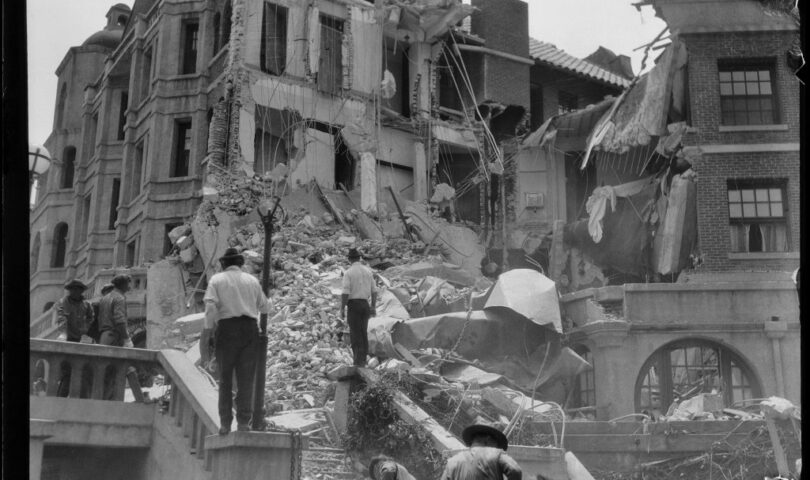On March 10, 1933, many southern Californians were sitting down to Friday night dinner when the magnitude 6.4 Long Beach earthquake struck – the deadliest known earthquake in the Los Angeles basin.
One of those who felt the quake’s power was Garden Grove teacher Allen Goddard, who documented the event in letters to his fiancé in Boston.




Aftershocks drive residents out of their homes
Just like today, damaging earthquakes bring fear and anxiety. Many families were too scared to stay in their homes with all the aftershocks, instead taking advantage of the mild winter weather to sleep and cook outside in their yards or public parks.




The community adapts after the tragedy
The community came together, along with US Navy sailors from the Pacific Fleet just arrived in San Pedro, setting up outdoor kitchens and relief stations.


![Black text on white background, reading:
"[excerpt from a letter by A. Goddard to his fiancé, Francelia Chittenden. Dated Mar. 13, 1933]
Returning to Garden Grove on East 7th St. we passed the Municipal Park where hundreds of army tents were pitched sheltering those without homes including what looked to be some hoboes here and there. Lunch was being served, free oranges of a poorer grade were heaped on the ground free for the taking, people sitting at picnic tables finishing their meal with sorry-looking faces. It was the least rosy of all the scenes we beheld. Some were out in cars, sitting in them as if they expected to lose even those next.
(text courtesy of the Orange County Historical Society)"](https://i0.wp.com/calconservation.blog/wp-content/uploads/2023/02/P-3-1.png?resize=730%2C410&ssl=1)
The local citrus industry even donated piles of free oranges.

Brick and mortar buildings failed
At this time, most retail, apartment, school, and industrial buildings were built with brick and mortar, which do well with heavy loads and strong winds (just ask the big bad wolf), but not well with sideways forces from earthquakes.



City structures not built for shaking
The earthquake caused major damage to cities built largely without consideration of earthquake shaking. From Santa Ana (Rossmore Hotel) to Long Beach, Compton to Pasadena (Huntington Hotel), buildings were destroyed.
Debris filled the streets.



Total damage was $50 million, or $1 billion today.
Trying to escape collapsing buildings ended up causing the most deaths
Ultimately, 120 people died. An investigation later reported about two-thirds of those deaths were caused by people being hit by falling bricks and architectural ornamentations as they tried to escape shaking buildings.
Remember, Drop, Cover, & Hold On is the best action during an earthquake.


If the quake had hit three hours earlier, deaths likely would have been in the thousands from school buildings collapsing on students and staff.
School building safety quickly became law


From Huntington Beach to Long Beach to Los Angeles, many school buildings were seriously damaged or destroyed. Because of this, sweeping changes were made to ensure public schools held up better in future earthquakes.



A new law, The Field Act, named after California Assemblyman Don Field, was passed in a mere 30 days after the quake.
Since the Field Act went into effect, no school building has collapsed, nor has there been any loss of life at a school site due to an earthquake. Learning from past earthquakes is the best way to ensure we are safer from shaking when the next big quake comes our way.
The California Geological Survey (CGS) Seismic Hazards Program provides technical information and advice to the Division of State Architect regarding geologic hazards to schools.

The earthquake also caused widespread liquefaction, where saturated sandy soils temporarily liquefy from shaking. This can even cause water & sand to “erupt” out of the ground & form “sand boils.” Mr. Goddard’s friend witnessed one of these in a nearby strawberry field.
![Black text on white background reads:
"[excerpt from a letter by A. Goddard to his fiancé, Francelia Chittenden. Dated Mar. 15, 1933]
Following story is vouched for by Walt [Lehnhardt].
Just following the earthquake a Japanese farmer came tearing over to the Lehnhardt home excited. “Water come up in strawberry field! No well, no irrigation. How come?”
Walt investigated and sure enough water was bubbling through a crack in the strawberry patch where no well or irrigation pipe had been. The quake had produced an artesian well to irrigate the strawberries.
(text courtesy of the Orange County Historical Society)"](https://i0.wp.com/calconservation.blog/wp-content/uploads/2023/03/liquefaction1.png?resize=726%2C432&ssl=1)

The 1933 Long Beach earthquake showed what a strong quake can do to the California urban landscape. It also demonstrated how communities come together to support each other…and how we can make changes now to reduce the impact next time.
Additional Information
For more information on the California Geological Survey, visit the website at www.conservation.ca.gov/cgs and follow on Twitter and Instagram @CAGeoSurvey.
Check out CGS’ 1933 Long Beach earthquake summary webpage for more details.
Follow Department of Conservation’s Facebook, Twitter, and Instagram for more on our role in managing California’s hazards, watersheds, and carbon while supporting the state’s economic development.
Media Sources
Media sources: The Los Angeles Times Photographic Archive, Library Special Collections, Charles E. Young Research Library, UCLA (https://bit.ly/3t00afy)
Department of Archives & Special Collections, William H. Hannon Library, Loyola Marymount Univ. (https://bit.ly/3hY4Ufi)
USGS Digital Media archives (https://on.doi.gov/3HXd3ex)
Text of Allen Goddard’s letters courtesy of @OC_History (https://bit.ly/3CwDDdg)












